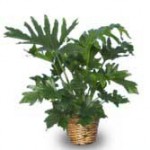Ask the Expert: What do I do to save my Schefflera? My schefflera is dying, I got it at my mother’s funeral in January, It’s done great until this week. I lifted up the inside pot to reveal, 3 inches of standing water, and something that I think is root rot? It’s leaves are all drooping. Can I save it? what should I do? I’ve been trying to drain the water off, and get the soil to dry, but it hasn’t yet. Any help is greatly appreciated. April
Plant Expert Reply:
Although you’ve had your plant for a few months, I suspect it is a result of a common problem that occurs with most funeral plants. Florist usually wrap funeral plants with a colorful water proof page and attach a bow. Why? because it makes a prettier presentation. This water proof paper doesn’t allow water to escape which for a funeral home vistition this is great. However, not so good for the plant in the long run. When you receive a plant from a funeral service remove the decorative wrapping. This will allow the plant to drain off excess water. Check the plant. Does it need to be repotted? If so, repot the plant.
In your case, your Schefflera was not able to drain excess water from the roots. Remove any wrapping that was around the plant or outer pot. Check the root and snip off any rotted roots and you might want to repot the plant. Dampen the soil so that it is moist but not soggy. Then give the plant sometime to recover. Be sure to keep the soil evenly moist. It might take a while but the plant should recover. Good Luck and keep me posted.


 Find Your
Find Your 











 Green Schefflera plants make great gift ideas!
Green Schefflera plants make great gift ideas!








